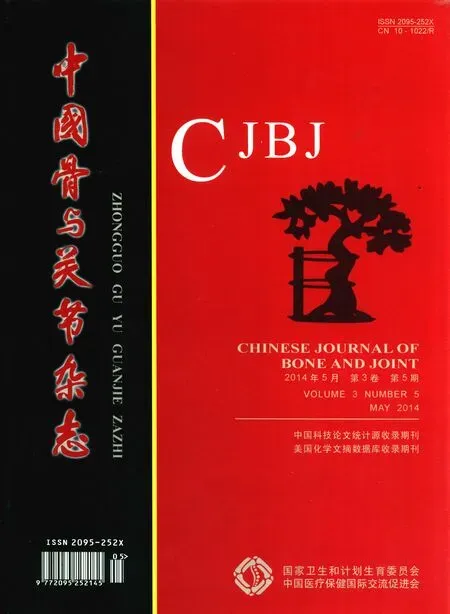严格掌握原发性脊柱肿瘤全脊椎整块切除的适应证
肖建如
严格掌握原发性脊柱肿瘤全脊椎整块切除的适应证
肖建如
原发性脊柱肿瘤相对少见,约占所有脊柱肿瘤的 20%,全身骨肿瘤的 6.6%~8.8%[1]。尽管原发性脊柱肿瘤的诊治原则与四肢骨肿瘤基本相同,但由于脊柱解剖复杂,毗邻脊髓神经、大血管及重要脏器结构,其外科切除难度较大、风险较高,既往多采用次全切除方式,局部复发率居高不下,治疗效果远不如四肢骨肿瘤。近 20 年来,随着脊柱外科技术的不断进步、脊柱内固定与重建器械的飞速发展及肿瘤学认识的逐步融入,脊柱肿瘤的治疗由过去的简单椎板切除、减压到现在的全脊椎切除,由过去的分块切除到现在的整块切除,使得脊柱肿瘤的临床疗效明显提高。
目前,手术切除仍然是原发性脊柱肿瘤最基本、最重要的临床治疗手段。脊柱肿瘤治疗相关的各种现代理念,不管是肿瘤学分期还是外科分期,其目的都是将肿瘤治疗的观念贯彻到脊柱肿瘤手术中来,以便科学地计划手术,达到治愈肿瘤的目的。
Enneking 等[2]于 20 世纪 80 年代初提出的肌肉骨骼肿瘤外科分期原则,奠定了骨肿瘤外科现代治疗理念的基础。Enneking 分期在骨肿瘤治疗中引入间室、外科切缘等肿瘤外科概念,通过系统分期判断肿瘤的生物学行为并确立手术切除方式和范围,在四肢骨肿瘤的治疗中取得了显著疗效,成为普遍接受的骨骼肿瘤外科治疗准则,并推动了骨肿瘤外科治疗的进步。根据 Enneking 分期的手术原则,对具有手术指征的 1、2 期原发性良性肿瘤,可采用囊内切除或边缘切除;对侵袭性生长的 III 期良性肿瘤与 I、II 期恶性肿瘤应尽可能采用边缘切除或广泛切除,并辅助以合理的系统治疗或局部放疗;对高度恶性的 III 期肿瘤,应联合术前辅助化疗,使肿瘤边界清晰、体积缩小,施行广泛性或根治性切除,术后辅以合理的系统化疗与局部放疗。
在临床应用中,由于脊柱周围解剖结构复杂,不同于四肢骨,Enneking 分期要求的手术边界在脊柱肿瘤中常常难以实现。如在脊柱肿瘤中施行根治性切除,则须牺牲脊髓或者神经根,造成的严重神经功能障碍是医患双方都难以接受的。20 世纪 90 年代初,一些脊柱外科医师开始在脊柱肿瘤外科治疗中运用 Enneking 分期理念,探讨原发性脊柱肿瘤的外科分期。1997 年,3 个国际性的肿瘤机构 Rizzoli Insitute、Mayo Clinic 和University of Iowa Hospital 阐述了一种新的分类方法,即 Weinstein-Boriani-Biagini( WBB )分期系统[3-4]。该系统综合临床、病理与影像学检查进行分期,在脊柱的横断面上根据肿瘤侵占的范围、解剖层次,作钟表面样放射状区域划分,依照外科切缘概念界定脊柱肿瘤切除方式,建立了脊柱肿瘤中应用 Enneking 分期原则的具体实施理念,旨在兼顾脊柱肿瘤总体切除的同时,力求保留脊髓这一重要结构。WBB 分期的应用和推广,使脊柱肿瘤相关国际学术交流与比较有了一个相对统一的标准,原发性脊柱肿瘤外科治疗由此翻开了新的篇章。脊椎周围骨膜、韧带与椎体上下软骨终板、纤维环构成限制肿瘤发展的天然屏障,每节脊椎形成一个被几个屏障包围的间室。依据 Enneking 分期和 WBB 分期理念,对原发性脊柱恶性肿瘤和部分良性侵袭性肿瘤,须进行全椎节切除术以求达到间室范围内切除肿瘤的目的。由于脊柱解剖的复杂性,从而对外科医生的手术切除技术提出了严峻的挑战。国内上海长征医院紧随其后阐述了 WBB 分期在脊柱原发性肿瘤外科治疗的应用,对手术入路、切除技术、术中出血控制与稳定性重建等手术相关问题进行了探讨,发现肿瘤切除率显著提高、手术并发症与死亡率均在可接受的范围内、局部复发率较过去显著降低[5]。
20 世纪 60 年代,Lievre 等[6]报道了对原发性胸腰椎肿瘤施行全椎节切除的少数个案报告。然而早期的全椎节切除技术实施方式多为分块切除,尽管确定了肿瘤切除范围,仍属经瘤手术,肿瘤细胞污染术野,易导致肿瘤局部复发。Stener 等[7]于 20 世纪 70 年代初首次提出了更加符合肿瘤学要求的全脊椎整块切除( total en bloc spondylectomy,TES )技术,沿边界整块切除肿瘤,最大限度减少了术中污染,降低了局部复发率。20 世纪 90 年代中期,Tomita 等[8]提出了从后路对胸腰椎肿瘤实施 TES 的手术技术,术中应用线锯将病椎自椎弓根断开,再于病椎上下分别截断,将整个病椎分附件和椎体两块切除。受当时手术技术条件所限,早期的 TES 手术存在耗时长、出血多、术后并发症发生率高等问题,也曾受到一些学者的质疑。但从肿瘤学的角度,TES 手术无疑是获取合理外科边界的更好手段,国内外各大中心相继进行了大量手术实践,TES 手术成为近年来脊柱肿瘤外科界聚焦的关键技术之一[9-10]。
随着技术的不断成熟与优化,单节段 TES 的手术时间由早期的 7~10 h 缩减至目前的 3~5 h,出血量由6000~10 000 ml 降低至 1000~3000 ml,手术创伤和并发症控制也获得明显改善。患者为手术付出的代价明显减少,实施 TES 的适应证得到了逐步扩大,早期认为的一些相对禁忌也被一一攻破。TES 较分块切除能更好地控制出血量,已形成众多学者的共识。为减少出血,TES 也被用于具有部分切除指征的良性血管瘤。切除节段数方面,2~3 个椎节 TES 切除的文献报道并非罕见,近期甚至有学者报道了 4~5 个椎节采用 TES 切除的病例[11-12]。实施节段方面,长征医院通过自制 TES 专用手术器械优化后路 TES 手术技术,进一步缩短手术时间、减少出血量、降低手术创伤和并发症的发生率,并将其应用节段由传统的下胸段、上腰段逐步扩展至上胸段、下腰段,成功实施后路 T2~3、L4~5等节段肿瘤的 TES 手术。
由于涉及椎动脉和颈神经根等重要结构,颈椎区的 TES 仍然存在巨大挑战。对 C2~3节段,可通过牺牲不参与臂丛神经的 C2、C3神经根和单侧椎动脉实现 TES 切除[13]。对下颈椎区域,目前仅能针对部分病例实施牺牲患侧椎动脉的大扇形矢状 TES 切除。长征医院已进行了这方面的尝试,成功实施了 2 例颈椎大扇形矢状 TES 切除术。
TES 技术现已成为众多中青年医生竞相追逐的热点,但应在 TES 的热潮中清醒地认识到:尽管 TES有着众多优势,其仍然只是控制肿瘤的技术手段之一,应按照脊柱肿瘤治疗理念严格掌握手术适应证;对良性肿瘤和预计生存期较短的转移癌,滥用 TES 将增加无谓的创伤和并发症,加大患者的代价。同时术者也应评估自身技术条件,不应盲目跟从,否则将导致难以挽回的不良后果。各节段脊柱肿瘤切除边界的个性化精准设计与实施、各病理类型肿瘤相关辅助治疗的优化与应用,仍将是今后脊柱肿瘤界共同努力的课题。
[1] Unni K. Introduction and scop // Unni K. Dahlin’s bone tumors-general aspects and data on 11087 cases. Philadelphia: Lippincott-Raven, 1996: 1-9.
[2] Enneking WF. A system of staging musculoskeletal neoplasms. Clin Orthop Relat Res, 1986, (204):9-24.
[3] Boriani S, Weinstein JN, Biagini R. Primary bone tumors of the spine. Terminology and surgical staging. Spine, 1997, 22(9):1036-1044.
[4] Hart RA, Boriani S, Biagini R, et al. A system for surgical staging and management of spine tumors. A clinical outcome study of giant cell tumors of the spine. Spine, 1997, 22(15):1773-82; discussion 1783.
[5] 肖建如, 贾边顺, 袁文, 等. 颈椎原发性骨肿瘤的外科分期及其手术治疗. 中华骨科杂志, 2001, 21(11):29-31.
[6] Lievre JA, Darcy M, Pradat P, et al. Giant cell tumor of the lumbar spine: total spondylectomy in 2 states. Rev Rhum Mal Osteoartic, 1968, 35:125-130.
[7] Stener B. Total spondylectomy in chondrosarcoma arising from the seventh thoracic vertebra. J Bone Joint Surg Br, 1971, 53(2):288-295.
[8] Tomita K, Kawahara N, Baba H, et al. Total en bloc spondylectomy: a new surgical technique for primary malignant vertebral tumors. Spine, 1997, 22(3):324-333.
[9] Bohinski RJ, Rhines LD. Principles and techniques of en bloc vertebrectomy for bone tumors of the thoracolumbar spine: an overview. Neurosurg Focus, 2003, 15(5):E7.
[10] Chi JH, Sciubba DM, Rhines LD, et al. Surgery for primary vertebral tumors: en bloc versus intralesional resection. Neurosurg Clin N Am, 2008, 19(1):111-117.
[11] Yoshioka K, Murakami H, Demura S, et al. Clinical outcome of spinal reconstruction after total en bloc spondylectomy at 3 or more levels. Spine, 2013, 38(24):E1511-1516.
[12] Luzzati AD, Shah SP, Gagliano FS, et al. Four- and fve- level en bloc spondylectomy for malignant spinal tumors. Spine, 2014, 39(2): E129-139.
[13] Rhines LD, Fourney DR, Siadati A, et al. En bloc resection of multilevel cervical chordoma with C-2 involvement. Case report and description of operative technique. J Neurosurg Spine, 2005, 2(2):199-205.
( 本文编辑:代琴 )
本刊正式被美国化学文摘数据库收录公告
本刊现为中国科技论文统计源期刊。2013 年 1 月,本刊经美国化学文摘数据库审理委员会审核通过,并从2013 年第 1 期开始,正式被美国化学文摘数据库收录。
特此公告!
《中国骨与关节杂志》编辑委员会
The indications of total en bloc spondylectomy for primary spinal tumors should be strictly mastered
XIAO Jian-ru. Department of Oncology, Shanghai Changzheng Hospital, Shanghai, 200003, PRC
Primary spinal tumors are relatively rare. Because of its anatomical complexity, adjacency to the spinal nerves, great vessels and vital organs and high degree of difficulty and risk of surgical resection, the therapeutic effects of primary spinal tumors are unsatisfactory. Currently, surgical resection is still the most basic and important clinical treatment method for primary spinal tumors. The musculoskeletal tumor staging system developed by Enneking et al. has been generally accepted in the surgical treatment of musculoskeletal tumors. According to this staging system, the resection approach and extension are determined by the biological behavior of tumors. In 1997, the Weinstein-Boriani-Biagini( WBB )staging system was published. After that, a relatively uniform standard was proposed in the international academic exchange and comparison related to spinal tumors, which was designed to take the overall resection into account with the spinal cord reserved. According to the Enneking and WBB staging systems, total vertebral resection should be performed in the treatment of primary malignant tumors of the spine and some invasive benign tumors, so as to achieve the aim of removing the tumors within the compartment. The posterior total en bloc spondylectomy( TES )technique developed by Tomita et al. for thoracolumbar spinal tumors is the most important means of acquiring reasonable surgical margins, with the advantages of short operation time, less blood loss, minimal surgical trauma, low complication rate and so on. However, the TES technique can only control the recurrence of tumors. If abused, there will be more trauma and complications. Therefore, the operation indications should be strictly mastered in accordance with the treatment concept of spinal tumors. The personalized and accurate design and implementation of resection margins of spinal tumors and the optimization and application of adjuvant therapy will be the subjects needing joint efforts in the feld of spinal tumors in the future.
Bone neoplasms; Spine; Neoplasm staging; Surgical procedures, operative; Spine neoplasms
10.3969/j.issn.2095-252X.2014.05.002
R738.1
200003 上海长征医院骨肿瘤科
2014-02-21 )

